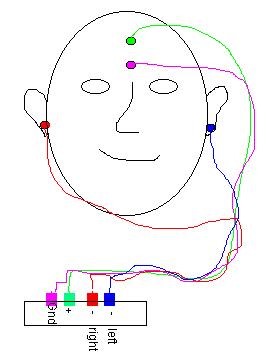ABR Electrode Application
1) ABR signals come from
a) the cochlea
b) nerves of hearing in the brain stem
c) nerves for understanding sound, in the brain
2) The ABR signals are:
a) small
b) large
c) mixed together with other nerve signals
d) both a and c
e) both b and c
3) The electrodes attached to the patients skin serve what purpose?
a) The are used to send a signal to the ear (stimulate the cochlea)
b) They send a signal to (stimulate) the brainstem
c) They measure the signals coming from the nerves of hearing
4) Why is it important to have clean skin where the electrodes
will be attached?
a) Because the impedance testing won't work unless the skin is clean
b) Because you cannot stimulate the ear if the skin is not clean
c) Because the electrodes need to pick up the tiny signal, and
dirt and dead skin cells make this harder
d) It is actually not important
5) The ground electrode is most commonly placed at the nasion or at the Fz location,
although it can go essentially anywhere.
Where are these locations? Can you visualize it?
6) What does A1 mean? What does M1 mean? Would you put an electrode that connects to the amplifier at the negative or positive input to the "physiologic amplifier" at this location?
There is some new information with this answer, so please be sure to check the answer even if you are confident of your answer.
7) Which electrode (location) is connected to the positive terminal of the ABR physiologic amplifier.
8) 
Assume that you have connected the following set-up. You measure the electrode impedances
as follows:
Pink to green - 3k ohms
Pink to red - 2k ohms
Pink to blue - 3k ohms
Do you need to reattach any electrodes, and if so, which one(s)?
9) 
Let's assume this time you measure the electrode impedances as follows:
Pink to green - 3k ohms
Pink to red - 7k ohms
Pink to blue - 3k ohms
Do you need to reattach any electrodes, and if so, which one(s)?
10) 
Let's assume this time you measure the electrode impedances as follows:
Pink to green - 10k ohms
Pink to red - 100k ohms
Pink to blue - 3k ohms
Do you need to reattach any electrodes, and if so, which one(s)?
Answer contains new information!
11) 
Let's assume this time you measure the electrode impedances as follows:
Pink to green - 20k ohms
Pink to red - 19k ohms
Pink to blue - 22k ohms
Do you need to reattach any electrodes, and if so, which one(s)?
Answer contains new information!
12) What does "braiding" the electrodes mean, and why is it done?
Answer contains a bit of new information.
13) What is the special consideration when putting the earphones
on the person?
Answer contains a bit of new information.
14) What do you think the advantages and disadvantages of disposable electrodes would be.
Answer contains new information.
Template / concept Copyright (c) 2025, http://audstudent.com/
All rights reserved.

